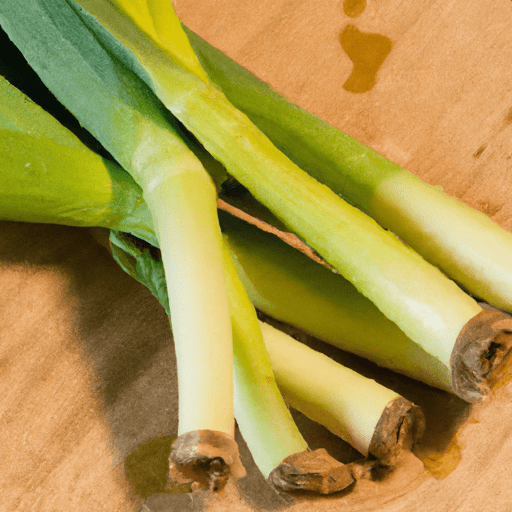Celebrating Baby Leeks: A Delightful Addition to Your Culinary Repertoire
Baby leeks may be small in size, but they certainly pack a punch when it comes to flavor and versatility in the kitchen. These miniature versions of their larger counterparts are tender, mild, and have a slightly sweeter taste, making them the perfect addition to a wide variety of dishes. Today, we will delve into the world of baby leeks, exploring their culinary uses, nutritional value, and uncovering some interesting facts along the way.
Taste Sensations
When it comes to taste, baby leeks offer a delicate and more subtle flavor compared to their fully grown counterparts. Their milder profile allows them to seamlessly blend into dishes, enhancing the overall taste without overpowering the other ingredients. Baby leeks have a slightly sweet edge and a tender texture, making them ideal for both raw and cooked applications.
Utilizing Baby Leeks in Your Kitchen
Baby leeks have become increasingly popular in the culinary world due to their versatility and unique flavor profile. Here are some of the most common ways to incorporate baby leeks into your cooking:
Sautéed Delight: Heat some butter or olive oil in a pan and gently sauté baby leeks until they become tender and lightly browned. This method brings out their natural sweetness and creates a delightful side dish or an accompaniment to meat, fish, or poultry.
Roasted Goodness: Toss baby leeks with a drizzle of olive oil, sprinkle with your favorite herbs and seasoning, and roast them in the oven. This brings out their sweetness and adds a caramelized touch, resulting in a fantastic side dish or a perfect addition to salads.
Fresh and Crunchy: Baby leeks can be enjoyed raw, offering a mild and refreshing crunch. Include them in salads, coleslaws, or use them as a colorful garnish to brighten up your dishes.
Creamy Soups: Add chopped baby leeks to your favorite creamy soups for an extra layer of flavor and texture. They provide a delicate onion-like essence that complements a velvety soup base perfectly.
The possibilities are endless when it comes to incorporating baby leeks into your culinary creations. Let your imagination run wild and experiment with different cooking methods to discover your favorite way to enjoy these petite delights.
Nutritional Powerhouses
Baby leeks not only add flavor and elegance to your table but also offer impressive nutritional benefits. Here are some key elements that make baby leeks a worthy addition to your diet:
- Antioxidants: Like their larger counterparts, baby leeks are a rich source of antioxidants, which help protect your body against harmful free radicals, reducing the risk of chronic diseases.
- Vitamin C: These petite leeks are packed with vitamin C, promoting a healthy immune system and aiding collagen production for healthy skin and connective tissues.
- Fiber: Baby leeks contain dietary fiber, which aids digestion, helps maintain a healthy weight, and keeps you feeling full and satisfied.
- Minerals: Baby leeks are a good source of essential minerals like potassium and manganese, contributing to proper nerve function, muscle contraction, and bone health.
A Peek into the Past
Throughout history, leeks have been celebrated for their culinary and medicinal qualities. Leeks have a longstanding presence in European cuisine, particularly in dishes originating from Wales, known for its national emblem, the leek. Ancient Romans and Greeks recognized leeks for their health benefits and considered them a symbol of victory and good fortune.
Baby leeks offer a delightful culinary experience with their delicate flavor, tender texture, and impressive nutritional profile. Whether sautéed, roasted, or enjoyed raw, these petite vegetables bring a touch of elegance to any dish. Add them to your shopping list, let your creativity flow in the kitchen, and savor the delectable flavors that baby leeks have to offer.
Baby Leeks
Origin: Baby leeks, also known as spring leeks or young leeks, are small and tender leeks harvested in their early stage of growth. Leeks originate from the Mediterranean region and have been cultivated for over 4,000 years. They are closely related to onions, garlic, and shallots.
Common Uses: Baby leeks are versatile and can be used in a variety of dishes. They are milder in flavor compared to mature leeks, making them ideal for raw consumption in salads or as a garnish. They can also be sautéed, braised, roasted, or used as an ingredient in soups, stocks, and stews.
Nutritional Benefits: Baby leeks are a good source of vitamins and minerals. They contain notable amounts of vitamins A, C, and K, as well as folate. Leeks also provide dietary fiber, which aids in digestion, and antioxidants that contribute to overall health.
Unique Properties: Baby leeks have a delicate texture and a subtle, sweeter flavor compared to their fully grown counterparts. They feature a slender white base and a thin green stalk. The white part is commonly used in cooking, while the green part can be utilized to add flavor to stocks or discarded if desired.
Historical Significance: Leeks have been part of various culinary traditions and are particularly significant in Welsh culture. The leek is the national emblem of Wales, symbolizing Saint David, the patron saint of Wales. On St. David’s Day (March 1st), it is customary for people in Wales to wear a leek or daffodil, another national symbol, to celebrate their heritage.
Remember to thoroughly clean baby leeks before using them, as they can sometimes retain soil or sand between the layers.




Use the share button below if you liked it.
It makes me smile, when I see it.